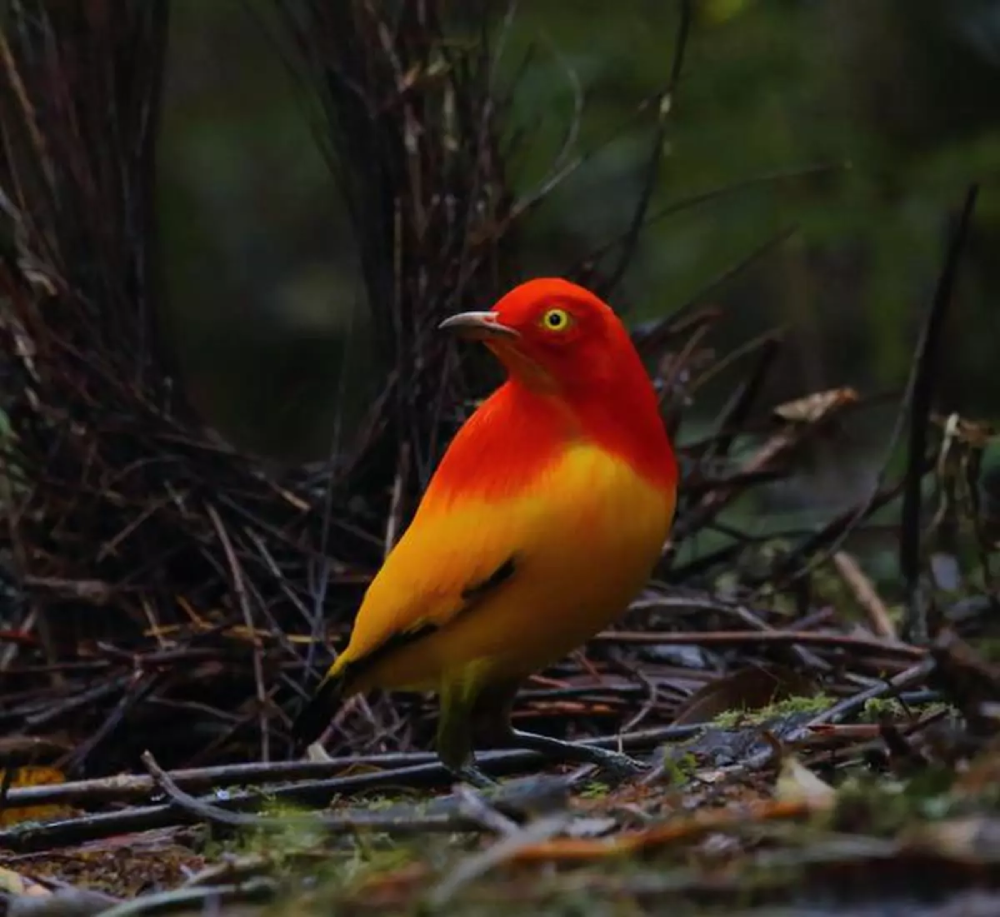Appearance and Habitat
The Flame Bowerbird is aptly named for the fiery hues that adorn its plumage, with males exhibiting a brilliant combination of orange, red, and yellow feathers that seem to glow like embers in the dim forest understory. In contrast, females are more subdued in appearance, sporting olive-green feathers that provide camouflage as they tend to their nests and forage for food.
These stunning birds inhabit the dense rainforests and montane forests of New Guinea, where they can be found flitting among the trees in search of fruits, insects, and small invertebrates. Their vibrant colors serve not only as a testament to their beauty but also as a means of communication, particularly during courtship displays.
Courtship and Mating Behavior
One of the most remarkable aspects of the Flame Bowerbird is its elaborate courtship rituals, which rival those of even the most extravagant birds-of-paradise. During the breeding season, male Flame Bowerbirds construct intricate bowers—avenues adorned with a variety of objects such as colorful flowers, leaves, feathers, and even man-made items like bottle caps and bits of plastic. These bowers serve as elaborate stages for the males’ courtship displays, where they showcase their plumage and perform a series of intricate dances and vocalizations to attract potential mates.
The courtship displays of the Flame Bowerbird are a sight to behold, with males engaging in elaborate routines that often involve fluffing their feathers, hopping from perch to perch, and emitting a range of melodious calls and chirps. These displays not only demonstrate the males’ physical prowess and genetic fitness but also provide females with valuable information about potential mates.
Females carefully evaluate the quality of a male’s bower and the complexity of his displays before selecting a mate. Once a female has chosen a suitor, the pair will engage in a brief courtship ritual before mating. After copulation, the female will construct a nest hidden among the foliage, where she will lay a single egg. She alone will incubate the egg and care for the chick once it hatches, while the male resumes his courtship efforts to attract additional mates.

Evolutionary Significance
The elaborate courtship rituals of the Flame Bowerbird serve as a striking example of sexual selection—a process by which certain traits evolve as a result of their attractiveness to potential mates. In the case of the Flame Bowerbird, the evolution of flamboyant plumage and elaborate displays has been driven by the intense competition for mates within their species.
By investing time and energy into constructing elaborate bowers and performing intricate courtship displays, male Flame Bowerbirds are able to demonstrate their genetic quality and reproductive fitness to females, thereby increasing their chances of mating success. In turn, females benefit by selecting mates with desirable traits that may enhance the survival and reproductive success of their offspring.
Furthermore, the unique behaviors and specialized traits of the Flame Bowerbird highlight the incredible diversity of avian adaptations and the important role that sexual selection plays in shaping the evolution of species. As scientists continue to study these magnificent birds, they gain valuable insights into the complex interplay between behavior, ecology, and evolution in the natural world.
Conservation Status and Threats
Despite their captivating beauty and fascinating behavior, Flame Bowerbirds face numerous threats to their survival, primarily due to habitat loss and degradation caused by deforestation, logging, and agricultural expansion. As their forest habitats continue to shrink and fragment, populations of Flame Bowerbirds are increasingly vulnerable to predation, competition, and other anthropogenic pressures.
Conservation efforts aimed at protecting the remaining rainforests of New Guinea are crucial for safeguarding the future of Flame Bowerbirds and countless other species that call these ecosystems home. By preserving intact forests, establishing protected areas, and promoting sustainable land use practices, we can help ensure that these magnificent birds continue to enchant future generations with their beauty and grace.
In conclusion, the Flame Bowerbird stands as a testament to the incredible diversity and complexity of the natural world. From its stunning plumage to its elaborate courtship displays, this remarkable species offers a glimpse into the fascinating interplay between evolution, behavior, and ecology. By studying and conserving the Flame Bowerbird and its rainforest habitat, we can gain a deeper appreciation for the wonders of nature and the importance of protecting biodiversity for generations to come.









